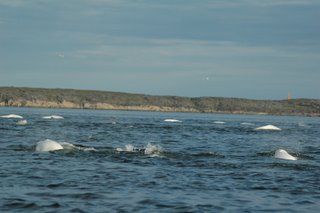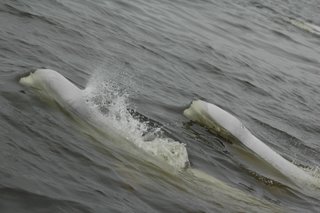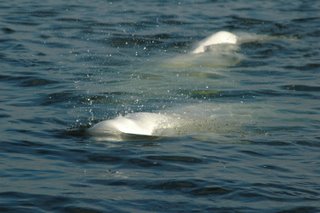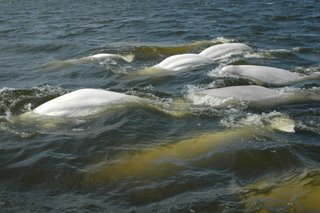Polar Bear Blog - Nudge Nudge - July 31, 2006
There is a place in Churchill, along the Churchill River, called The Flats. It used to be populated by the remnants of the homeguard Cree and a few white trappers in the early days of Churchill. Today, it has kind of a shanty town feel, still hanging on to a slower pace of life (yes, even slower than Churchill itself) and another era. It is also been reputed as a good place to occasionally 'feel no pain'.
One local, who for dramatic purposes we will call LL, was definitely 'feeling no pain' this weekend as a late night party drifted along on the riverbank. Finished for the evening, he headed, not quite straight, for home. The nice thing about the flats is if you need to rest before you get home you can.
So, LL was resting alongside the road when he was awakened by a gentle and persistent nudging. He growled awake, as many of us are prone to do returning from dreamland, with his fists and teeth clenched, ready to clobber this intrusion. Turning, he came eye to eye, although still relatively at ground level but eye to eye nonetheless, with a big ol' polar bear.
Seems this bear had been poking at him with its nose, possibly sizing him up for a meal, possibly just trying to wake him up. Regardless of its intentions, it more than succeeded in the latter.
Polar Bear Alley
Polar Bear Alley follows the ice-free season of Hudson Bay when the Polar Bears of Churchill are on land. Based out of a cabin fifteen miles east of Churchill, Manitoba, Canada, it is a local view of the arctic, climate change and northern life.
Monday, July 31, 2006
 Polar Bear Blog - East Wind - July 31, 2006
Polar Bear Blog - East Wind - July 31, 2006
A strong east wind is terrorizing the tundra today. The plants and trees bend to its will, in colourful subjugation (sorry... I had to use that line, it was the first thing I thought of when I saw the fireweed in my yard...and yes, I am sober...relatively).
It has been a great summer for fireweed, one of Churchill's more prolific plants. As a disturbance vegetation, it grows on old roads, building sites and gravel pits, and since the military was in Churchill for about forty years, testing ordinances, vehicles and personnel, pretty much everything has been disturbed at one time or another.
Fireweed is a brilliant purple, growing tall maybe two or three feet in places. A series of flowers adorns the top third of it, emerging from a thick stalk with sharp, green, almost snapdragon-like leaves.
And they are tasty leaves. Fireweed is one of the more edible plants up here - the young leaves, stems and flowers all can be eaten raw or cooked (with butter). It is a nice addition to a salad, tasting, in my opinion, a little like nasturtium (a little spicy).
Sunday, July 30, 2006
Polar Bear Blog - Bears Again! - July 30, 2006
Finally, a polar bear update on the polar bear blog.
L5, Churchill's recycling centre, is chugging along, at least at the local level, who knows what is going on in the bureaucracy above. Anyway, there is still garbage in there waiting to be shipping out and still bear attractive smells. However, most bears have either been escorted away by Manitoba Conservation or have simply moved on once they decide it is too much effort to break-in to the building.
Of course, not ALL bears think it is too much effort. There is one mid-sized young male that has become kind of a resident at L5. He comes around at night or early in the morning and sneaks in only to disappear during the day when Conservation Officers are looking for him.
While town workers keep upgrading the defences to L5, he keeps finding innovative methods of accessing this big, wonderful pile of rotting garbage.
One of his latest excusions into L5 came at the expense of the back wall. Since all the windows are barred, this bear simply peeled away the wall, wood, insulation and all, and squeezed in to the building. An eight foot drop off a rock face and he was in.
Of course, he has been 'busted' by town employees one or two times. Last week, in his panic to escape, he actually squeezed UNDER the iron gates at L5. Those gates are only 10" off the ground. If a bear can get his head through something, you can be assured that the rest of him will somehow squeeze through as well.
Stay tuned for the hide and seek updates this summer.
Thursday, July 27, 2006
Polar Bear Blog - Munck Revised - July 26, 2006
Another entry for today... you see, I could write about Jens Munck everyday because he was a pretty cool cat...and tough as nails. In fact, when I first came to Churchill, I told everyone I was going to open a martini bar on the tundra called Munck's Cafe. Of course, Munck's Cafe only ever existed in my mind, although I must say the occasional martini does get served there.
Anyway, this is my Munck revised entry and Munck has truly been revised. I took Lawrence Millman, a writer and, much like myself, arctic groupie, over to the Munck site yesterday. It was a fabulous walk, something done by very few people but something that more people should do!
We scrambled over rocks, followed 400 year old maps and variously debated, argued and agreed over where and what was where and what at the old Munck site.
What baffled us, however, is that we both agreed that we had found the original site of Munck's ringbolts or ship mooring. In effect, the first and only remaining evidence of Munck, a.k.a. the first Europeans EVER to visit Churchill.
But there were no ringbolts. Only iron stains weeping down the rock and two chunks of proto-quartzite chipped out of the rockface. Naturally, these were the former sites of the mooring rings.
Now, I understand the argument for removing this wonderful little piece of history but I hate it. It is accessibility. If we chip these rings out of the rock and bring them into town, everyone can see them. Sure, they are completely out of context and really have zero meaning left in them, but people can see them.
There are some things that are meant to be remote and are meant to be challenging and are meant to mean something. This is another part of Churchill's history that is simply gone. Churchill is in a transition and I don't think I like it.
Polar Bear Blog - Munck Site - July 26, 2006
The old bones are sore today. Yesterday was another full day of hiking across river. Another perfect day across river, eight hours of sun and occasional cloud and just enough wind to keep the blackflies and mosquitoes at bay.
Crossing the river to Cockles Point (the old site of White Whale Lodge - more about that later...), we started our journey south to the old town site and the original wintering site of Jens Munck.
Munck was the first European to overwinter in the Churchill area and one of the first Europeans to enter Hudson Bay. In 1619, the 64 men of the Munck expedition arrived in the Churchill River and set up camp in the first suitable cove, preparing for winter.
Things started off pretty well. It was late August and they found berries and game. They caught and rendered a beluga whale which inevitably attracted a polar bear, which they shot, anticipating a hearty meal for the entire crew.
Of course, that is where things sort of went astray. Only Munck as Captain cooked his polar bear meat. The rest of the crew, both as tradition and as a means of saving valuable fuel, only marinated the meat in vinegar. And here is where the problem lay.
Polar bear meat is today well known for containing high levels of trichinosis, a parasite that eats away at you and your immune system, most commonly found in raw pork.
Well, to make a long story short, the following summer Munck and the two remaining men, dragged themselves up the rocky shoreline to gather berries and eventually gain enough strength to sail one of their ships, the Lamprey, back across the Atlantic - an incredible journey that is virtually unnoticed in the annals of arctic history.
The problem was is that Munck was kind of cursed. When he got back to Denmark, he was thrown in jail (for one of his sailor's crimes), the king harangued him for leaving his favorite ship halfway across the globe, not to mention his wife had left him and thrown away most of his clothes. Munck would only be released from jail when King Christian of Denmark started running out of breathing sea captains in his latest naval conflict. It was in this conflict that, from a distance, Munck watched the Lamprey sink. Despite his iron will, that moment was what ultimately broke him and he gradually declined until his death back on land in Denmark. He is buried in an unmarked grave.
Wednesday, July 26, 2006
Polar Bear Blog - Belugas Galore - July 25, 2006 I will have a polar bear update pretty soon. They have been up to some crazy things around here but this is peak beluga whale season and the river is pretty amazing right now.
I will have a polar bear update pretty soon. They have been up to some crazy things around here but this is peak beluga whale season and the river is pretty amazing right now.
Yesterday was a good day. There were two accessible high tides (9am and 9pm) meaning that I spent four or five hours out on the river watching whales. Heading out at 7am, I ended up being all alone on the river with probably 3,000 whales. With the capelin running, the whales were active, hunting and herding schools of these little fish. It was so still that you could even hear their echolocations through the hull of the zodiac boat. Hearing these spooky, spacey sounds, you really get an idea why old sailors used to called these whales the 'canaries of the sea'.
With the capelin running, the whales were active, hunting and herding schools of these little fish. It was so still that you could even hear their echolocations through the hull of the zodiac boat. Hearing these spooky, spacey sounds, you really get an idea why old sailors used to called these whales the 'canaries of the sea'.
The belugas come into the river to give birth and moult and eat and generally relax in the warmer waters of the estuary. With numbers peaking right now, it is pretty common to see 360 degrees of whales once you are out in the channel, ranging from bright white rippling bulls to gangs of grey sub-adults to mothers gently swimming under their newborn babies, supporting their first efforts at swimming. Heading out today to cross the river and hike to the old Jens Munck site. Should be fun assuming we do not get eaten by a bear.
Heading out today to cross the river and hike to the old Jens Munck site. Should be fun assuming we do not get eaten by a bear.
Monday, July 24, 2006
Polar Bear Blog - Northern Harrier Cruising By - July 24, 2006
I should probably just change the name of this blog because everything up here is way too neat not to write about. So today I'm talking about birds. Actually, just one bird, in fact, a raptor that is cruising around just outside my window right now.
It is a Northern Harrier (the one's the fighter jets are named after) hunting and hovering around Camp Nanuq. Harriers, also called Marsh Hawks up here (as opposed to seagulls which are called sh*t hawks up here), are fairly common migrants to the Churchill area. This one is a female, dark brown, highlighted by a white bar across its narrow tail. She is pretty large for a harrier, probably 2' long with a 4' plus wingspan.
They seem precarious and graceful at once, flying low over the tundra or teetering 10-12' off the ground searching for prey, sometimes stopping in mid-air to scan, motionless and impossibly aloft, looking and listening for anything at all. They cruise along hunting lemmings and voles, the arctic's rodents - our version of mice minus the tail.
Harriers and other raptors track their prey with their highly develped eyesight. At least 8x superior to man's, they can spot movement from impossible distances and may even be able to track prey by the residue of their warm little bodies, creating almost a 'Mondrian' grid of neon heat traces on the tundra.
Even their predatory look is an adaptation to hunting. Their hooked beak adapted to tearing flesh and their equally hooked brow adapted to shield their eyes, both from sun and flailing little rodents.
Sunday, July 23, 2006
Polar Bear Blog - July 23, 2006
We are soaked in a thick fog this morning, my own lake barely visible. Think of it as a hangover from last night's antics; a continuing barrage of lightning and thunder and torrential rain.
This seems to be the result of a hot northern summer. While Churchill has enjoyed a very reasonable 15-20C, the rest of the northern Manitoba has been up around 25-30C. As the air warms over the land, south winds begin to push this air north towards the bay, creating tremendous, billowing cumulus clouds along the way.
Two years ago, we watched these thunderclouds turn over on themselves as they moved over Churchill and onto the cool, brackish water of Hudson Bay. With their puffy domes and towers collapsing, the clouds turned their anger from the Bay to our town. We went from the hotspot in Manitoba at 25C to the cold spot (around 5C) and golf ball size hail in less than five minutes.
Yesterday, you could see the storms building on the horizon by about 1 or 2 pm. It would take about five hours for them to reach Churchill and unleash their fury. Nevertheless, it was pretty amazing, provided that you were inside.
The only real problem with these incredible lightning displays is for the polar bears. Often, with storms such as these, the majority of the rain occurs when they reach the coast. The same cannot be said for lightning. Considering this has been a fairly dry summer, the northern forest and tundra can ignite quickly.
Coming from the south, these lightning strikes occur directly over the polar bear maternity denning area. Any fires in there destroy polar bear dens that have been active for decades. With little suitable habitat available for new dens, this can be a major difficulty for the western Hudson Bay bears.
Here is a link to the forest fire update from the Province of Manitoba. So far, it looks to be a fairly reasonable fire season in the north (click here for historical fire information - 1914-2004) but scientists figure that a changing climate will mean more dry summers, more lightning strikes and more challenges for the polar bears of Churchill.
Return to www.polarbearalley.com
Saturday, July 22, 2006
Polar Bear vs. Beluga Blog - July 22, 2006
So, there is a film crew in town this weekend creating a documentary about Churchill's beluga whales. As it turns out, I know the director - from ages ago and from strange and random encounters every few years.
Anyway, I agreed to do an interview and helped them find a few other locals with whale stories, true and otherwise. During this interview, she focused on polar bears vs. beluga whales and asked if there was a future for beluga whales tourism in Churchill.
I thought for a bit and finally said 'no'. It is a strange answer considering Churchill's has some of the best whale viewing opportunities in the world - on a good day there are 3,000 whales in the river, on a bad day there are 300. Belugas swim right up to the boat, around and under it. It is pretty cool and really should be a model for tourism development in the rest of the arctic.
But, we really only get three or four thousand visitors through the summer - a pretty small number that is either stable or even declining. This is mostly due to the fact that it costs a lot to get up to Churchill - around $1000 just to fly from Winnipeg. You can do it cheaper by driving to Thompson and hopping on the train - but the combination of heavily loaded grain cars and summer heat have kind of wrecked the tracks and you have to expect the train to be late (which can be part of the charm...).
Things are different in October, chartered flights come into Churchill on a regular basis and several travel companies organize trips to Churchill to see polar bears. There are a lot of options.
Of course, this is due to twenty years of marketing and promotion by National Geographic, BBC, etc... Churchill's belugas were just overshadowed by the bears and only now is limited media interest being shown to them.
But beluga enough doom and gloom - this doc looks kind of neat and might change the way, at least, Canada views Churchill's whales. Plus I was wearing my 'I Club Baby Seals' shirt for the interview so maybe Paul McCartney will come up here next year for a benefit concert!
Friday, July 21, 2006
 Fresh from his scrap with a savvy female polar bear and her cubs, this grizzled old male plods inland for some peace and quiet, and a good scratching in the willows along Hudson Bay.
Fresh from his scrap with a savvy female polar bear and her cubs, this grizzled old male plods inland for some peace and quiet, and a good scratching in the willows along Hudson Bay.
(taken on Tuesday, July 18th)
www.polarbearalley.com
 Haven't downloaded my photos from yesterday yet, but this is one of my favorites from last year. This is a group beluga whale bulls swimming in the Churchill River.
Haven't downloaded my photos from yesterday yet, but this is one of my favorites from last year. This is a group beluga whale bulls swimming in the Churchill River.
I will post a few more pictures at my main site - www.polarbearalley.com
Beluga Blog - July 20, 2006
Headed out on the river today with a couple friends in search of whales. It was a fairly slow day so we only saw 50 or 60 whales but it was still pretty amazing.
Usually there are around 3,000 whales kicking around the river, swimming in and out with the tides. The last few days have been a little quiet (but still awesome), a few locals figure that an Inuit boat might be in town or passed by. Inuit still hunt whales up north and word spreads just as fast among the belugas as it does from the Gypsy Bakery gossip table in Churchill so the whales are a little shy for a few days afterwards.
This afternoon, however, their shyness finally passed. After floating around for a while, we eventually found a family pod of mothers and their young. They were chasing a school of capelin (kind of like a little sardine) across the tide line (where the salt water tide meets the fresh water of the river).
We trolled along beside for maybe 20 minutes before heading back. Most of the time the whales were about 10' from the boat, their scarred back shining in the afternoon sun. I should have some video to post fairly soon. Another good day in Churchill.
Still a lot of bears around, two were hanging out around L5 today and we heard shots behind the Town Centre Complex while we were in town - a sure sign of an unwelcome visitor to town.
Wednesday, July 19, 2006
 Here is a quick post of the bears sparring in Hudson Bay yesterday. I don't have a $30,000 lens but you get the picture. The bay was like glass, sunny with a cool breeze and all you could hear was the splashing and grunting of two polar bears....and a gazillion biting insects swarming around us. Paradise!
Here is a quick post of the bears sparring in Hudson Bay yesterday. I don't have a $30,000 lens but you get the picture. The bay was like glass, sunny with a cool breeze and all you could hear was the splashing and grunting of two polar bears....and a gazillion biting insects swarming around us. Paradise!
Polar Bears of Churchill Blog- July 18, 2006
What a difference a garbage dump makes. Last year was pretty normal, sometimes you could run into a polar bear at the dump or occasionally see one lying on the coast but you a lot of them just camped out in the willows near the dump, a nice covert place to spend the day. This year is something quite different.
Today, we went for a drive along the coast to check out if the rumors of mass bear activity were true. Wow, were they true. All told we ran into ten different bears between the airport and halfway point (we did not even reach the site of the new recycling centre!)
The day started with two bear sparring in Hudson Bay. These two were wading neck deep in the bay, wrestling, mouthing, punching, body slamming, you name it. Pretty amazing since it was about 17-18C here today.
They were probably siblings, maybe two or three year old 'cubs' since a female was swimming near them, eventually coming ashore when they would not stop fighting. She found a spot on the sand and watched them, nervous and annoyed, maybe a little glad that she will push them away and head back on her own pretty soon.
Soon, a large male (likely 1,000+ lbs) swam by, creating an unintentional disturbance to their splashings. However, he was intent on some destination to the east and once he swam intently by (acutally, through) they resumed their playfighting once again. This sparring continued for at least an hour.
We skirted the coast and pulled up on a beach hoping to 'head him off at the pass' and catch another glimpse of him and what we found was a mother and two 'coys' or cubs of the year, investigating an old metal structure on the coast before continuing down the coast.
Soon, the big male came back into view still purposefully swimming, however as he passed our little family came back into view, apparently deciding that a swim was a nice idea. However, they swam right in front and around of this big male.
Females usually keep their cubs away from male bears, wary of these lumbering, predatory hulks. But, confident or crazy, this one took her family right by him, almost baiting him. And, of course, it worked. His interest piqued, he relented from his seemingly unrelenting path and turned on her.
Chasing her cubs through the water, he closed in and forced her hand. She turned and lunged right at him, meeting his seal-breath head-on. One or maybe both of them uttered something between lion's roar and a wild boar but whatever it was, it left us uttering absolutely nothing but 'wow'.
The drama over, the continued their afternoon swim as though nothing had happened at all.
A friend of mine insisted that the closure of the dump would completely change the dynamics of Churchill's polar bears. So far it appears he is right.
Monday, July 17, 2006
Polar Bear Blog- July 17, 2006 (6:45pm)
Wow, two blogs in one day - that is a lot of excitement for my cabin. Actually, this looks like the start of a lot of excitment for Churchill this summer - I may have to retract my air conditioning for polar bears rant.
Just got an email from Nature First Tours (a local tour company) and their tour today saw fourteen polar bears! Fourteen polar bears on July 17th!!! Crrr-azy!!!
I also hear there are five bears at the Canadian Eskimo Dog Foundation Headquarters - also called Ladoon's (more about that later). And I am assuming a few more at L5 (I should just make a Churchill terminology page...)
So it looks like there were a few bears on that big patch of ice...and now there are a few less bears on that ice. Maybe I will head out for a drive tonite and see what's up for myself.
First blogspot from Churchill
Hey there, thought I would start posting my polar bear blog on blogspot. Not sure why I am doing it but i suppose a book will magically appear from all of this by January. My other postings are at www.polarbearalley.com because I am not sure how to post them over here in any way that makes sense.
Polar Bear Blog - July 17, 2006
The return of northeast winds has also brought the Churchill's last icefloe into sight. The last remaining ice has long since packed up along the southern coast of Hudson Bay and there is really just one little hunting platform along this side of the bay, likely with a few bears hanging on.
While there are still some bears on the ice, many have come ashore. Usually how this whole thing works is that bears with higher energy demands and/or less fat tend to come ashore first. This includes pregnant females, mothers with young cubs or subadult (3-5 year old) bears.
Pregnant females swim ashore as the ice floats south from Churchill to York Factory. One of the largest denning areas is close to Churchill, lying about 30 kilometres south. Females are pretty site specific, as in they like to hang out in familiar territory and even den quite close to where they were first born.
So, they swim ashore up to two weeks before the last polar bears come off the ice. And, of course, these are the big fat boars, lumbering around at 700-800 kilograms plus right now. They stay on the ice to the bitter end, swimming ashore, somewhere east of York Factory this year. With no particular place to go, they simply hang out on beach ridges and slowly walk north along the coast until some of them end up at Cape Churchill in November.
Sea ice map of southern Hudson Bay (from York Factory east)


